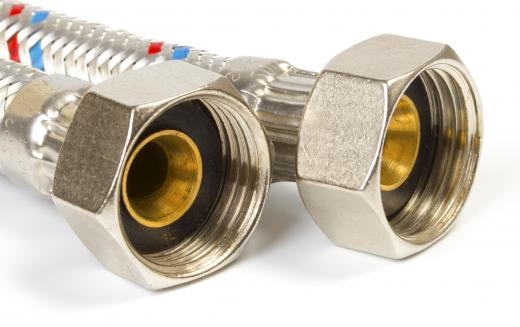Nominal pipe size (NPS) is a standardized measurement used to describe the size of pipe in North America, while other regions use the metric diametre nominal (DN) measurement system. This system of measurements is closely, but not exactly, correlated with the actual size of the pipe, and the system used for describing pipe measurements can get rather arcane. For instance, lower nominal pipe size reflects the approximate inside diameter, while higher numbers are based on the outside diameter.
In addition to nominal pipe size, the thickness of the walls is also subject to standardized measuring guidelines. The “schedule” of a pipe refers to the thickness of the walls, which can have an impact on the interior diameter. Identical nominal pipe sizes may have different interior diameters as a result of being at different schedules. Both sizes are needed to determine which pipe is appropriate for an application.

Information about the nominal pipe size may be stamped onto a pipe or added to a sticker mounted on the pipe to provide information to consumers. Contractors can seek out the pipe they need at a hardware supply or order it directly through a supplier. The variances between actual size and nominal pipe size must be accounted for in project design, as pipe of the wrong size can cause significant problems with pumping and other piping activities.
Pipes made from any material can be measured and sized using this standard. Manufacturers use careful quality control checks to make sure their pipes stay within tolerances. Small errors in piping can become a problem on a job site, where the errors may make it impossible to create a secure connection, or could create leaks and other issues. In the event the nominal pipe size information is inaccurate, it is usually possible to take the pipe back for return or exchange, as the product is defective.
Conversion charts are available to assist people with conversions between nominal pipe size and diametre nominal. Some charts simply provide a one to one between these two systems while others may note the actual diameter of the pipe, also indicating whether it is the outside or inside diameter. Schedule measurements can also be converted for the benefit of contractors who need to know about pipe wall thickness for various project needs. Such charts may be posted at hardware stores for convenience and can also be found readily online, particularly at plumbing websites with information on different kinds of piping.
Ever since she began contributing to the site several years ago, Mary has embraced the exciting challenge of being a About Mechanics researcher and writer. Mary has a liberal arts degree from Goddard College and spends her free time reading, cooking, and exploring the great outdoors.

